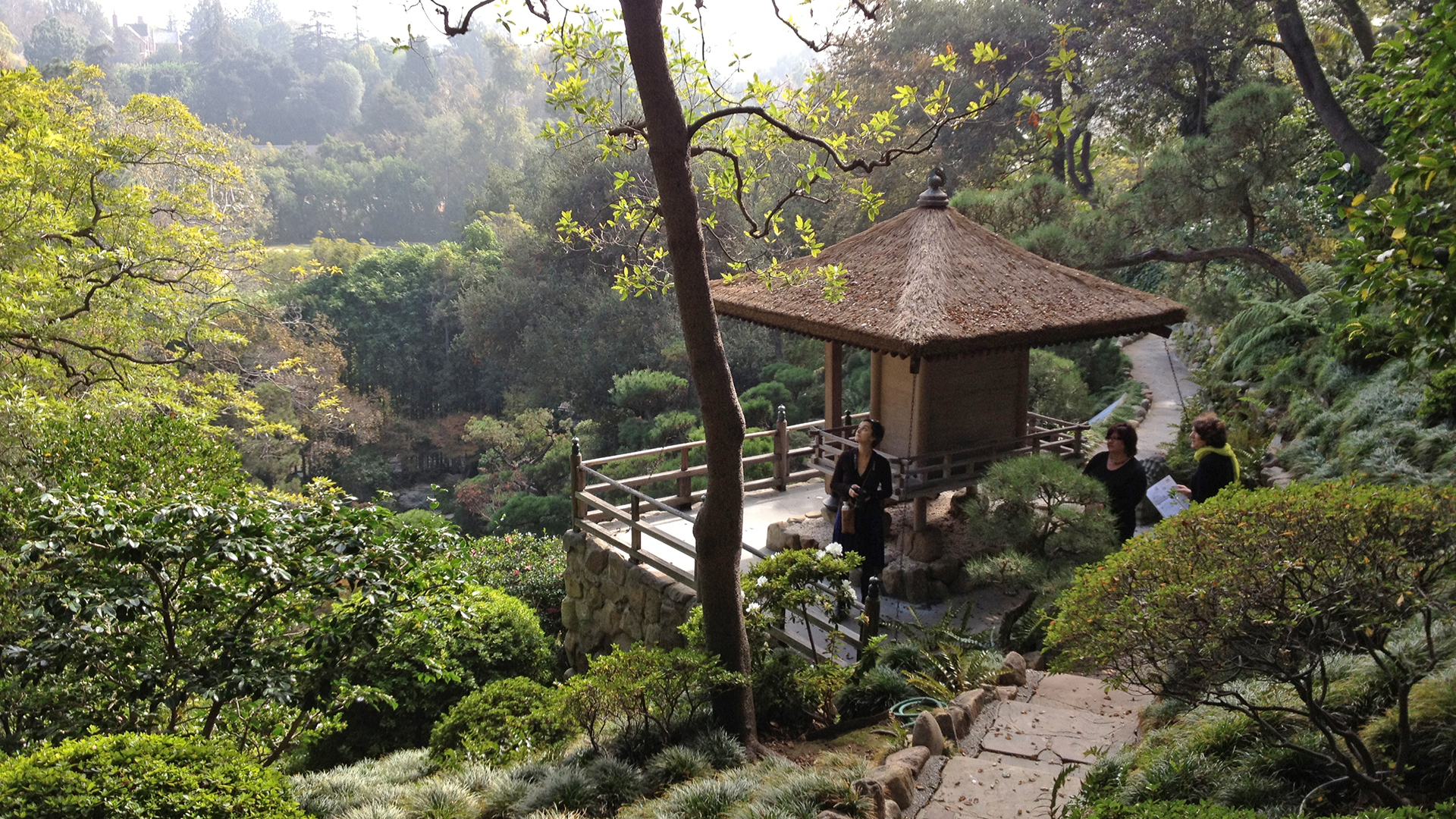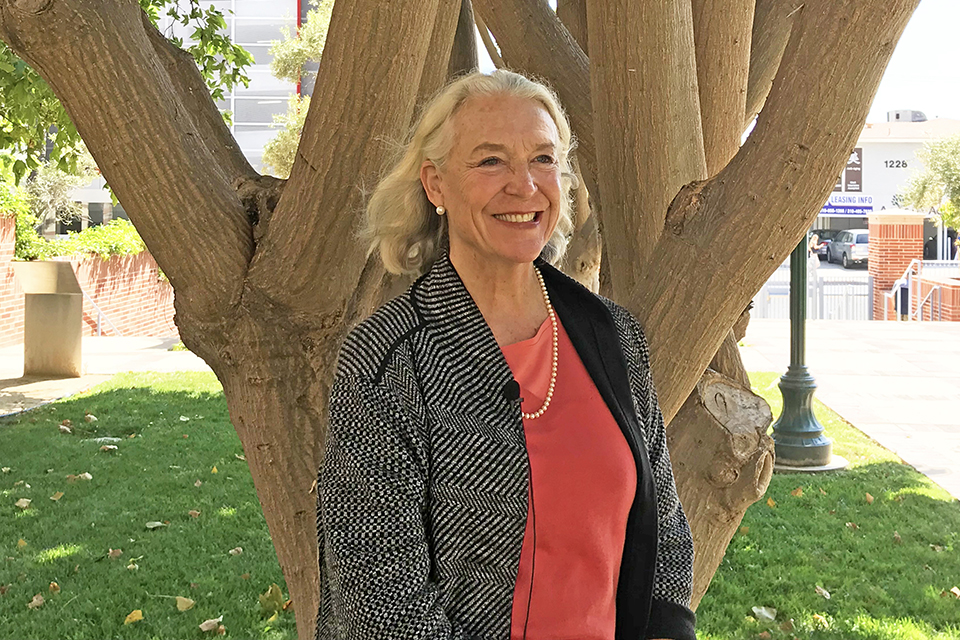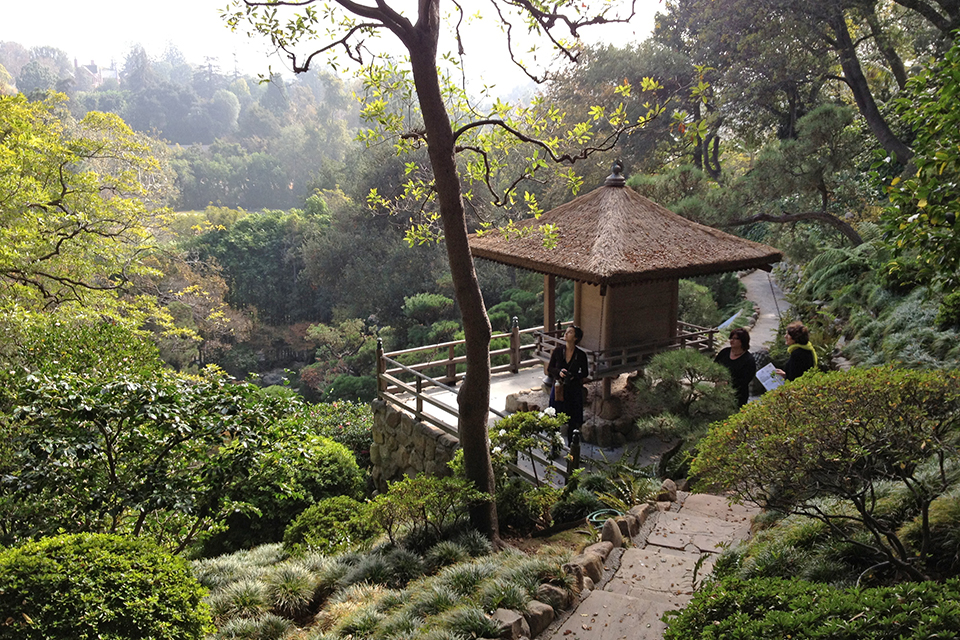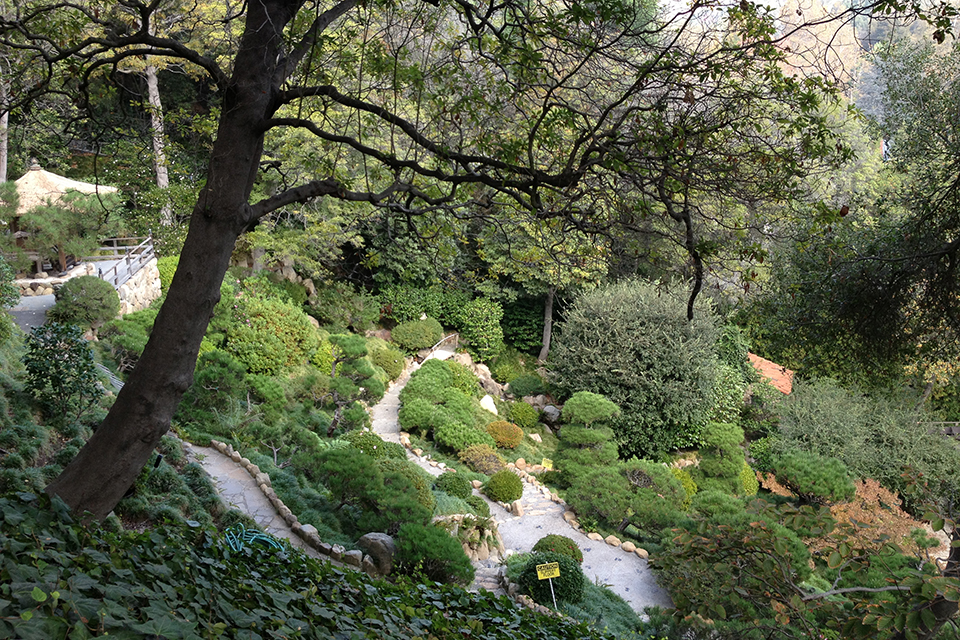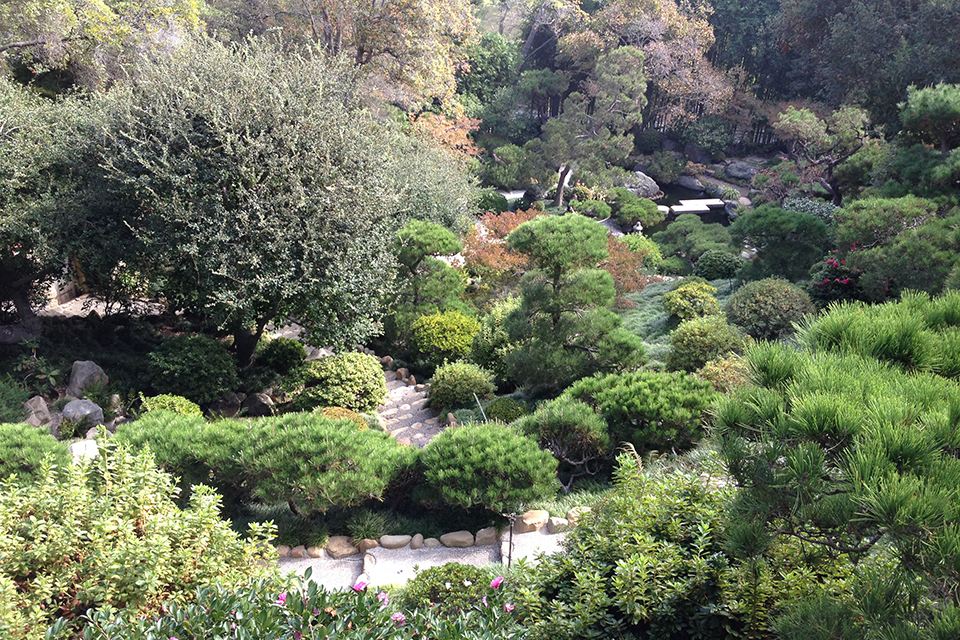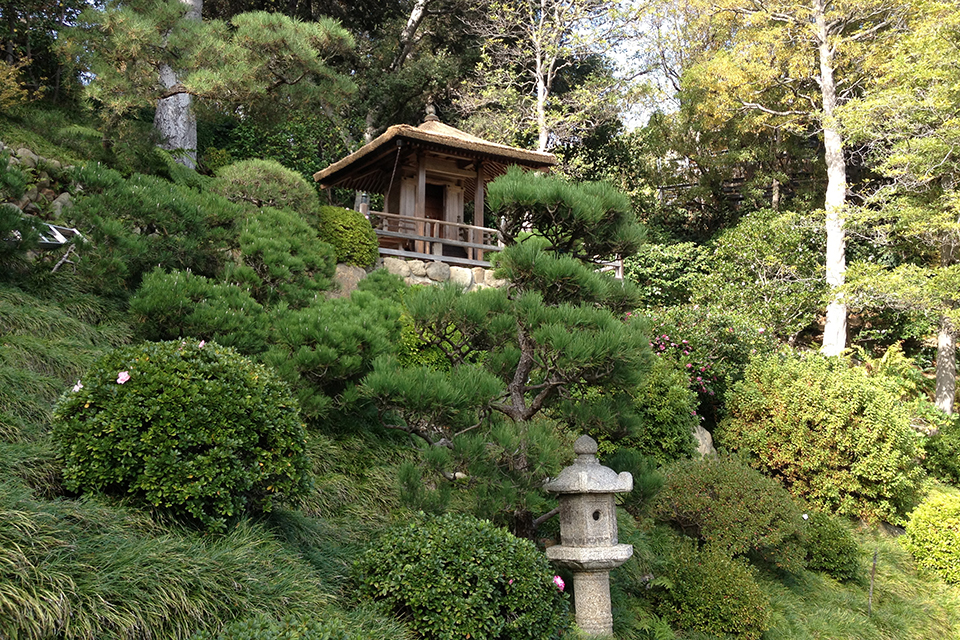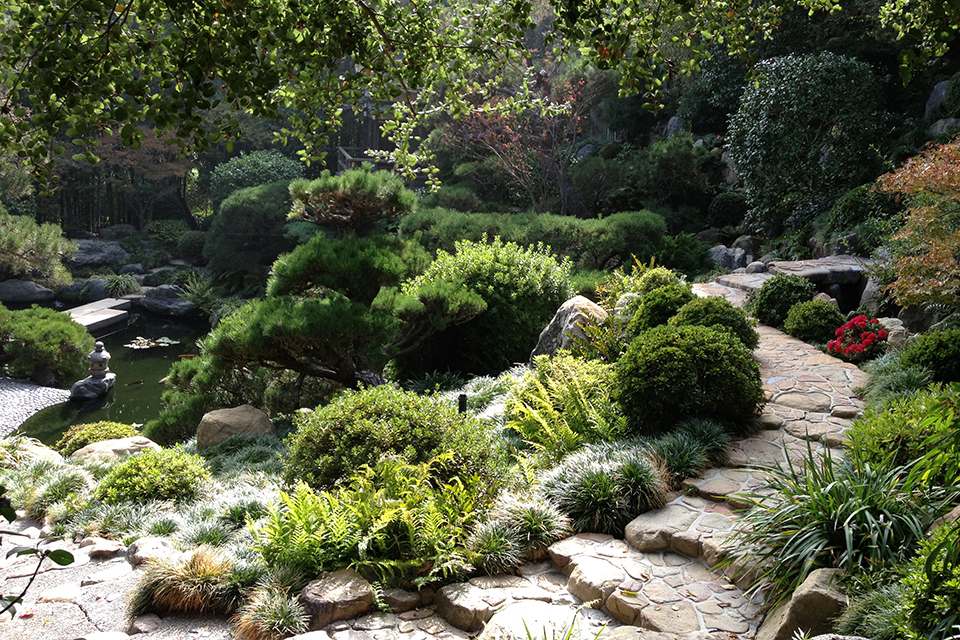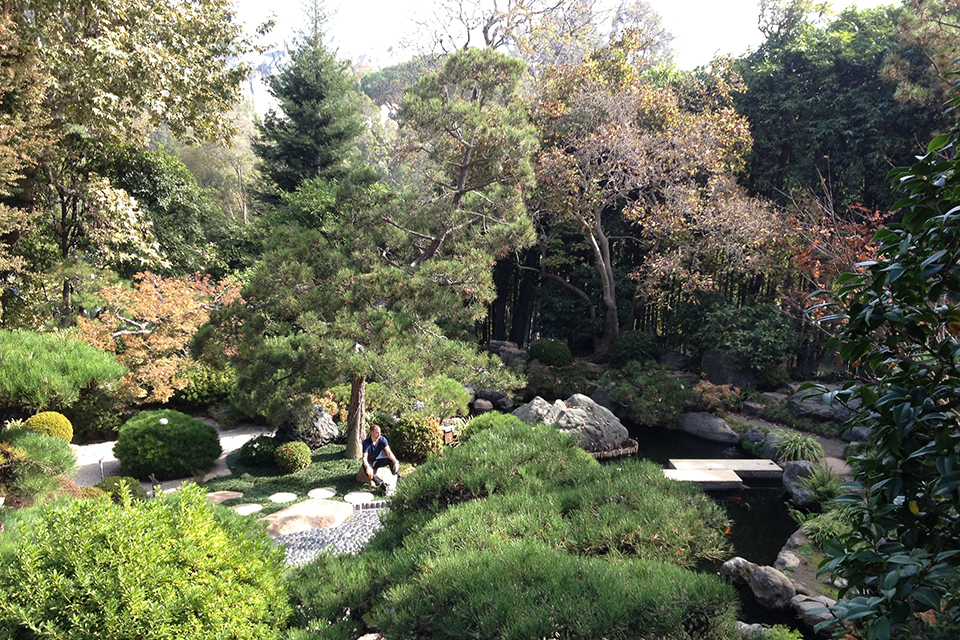In 1923 landscape architect A.E. Hanson created a Hawaiian-inspired retreat for Harry Calendar in the Bel Air subdivision of Los Angeles. Gordon Guiberson purchased the property in 1959 and commissioned Nagao Sakurai and Kazuo Nakamura to create a Japanese-style garden on the steep 1.5-acre hillside below the residence. Sakurai had recently immigrated to the U.S. and had previously designed the Imperial Japanese Gardens at the 1939 international expositions in San Francisco and New York. Nakamura was a renowned garden expert from Kyoto, Japan.
Background
The new plan kept intact elements from Hanson’s design, including a Hawaiian garden, a twenty-foot waterfall, and a stone bathhouse. Sakuri and Nakamura sculpted a dramatic garden, inspired by those in Kyoto, into the steep hillside, using 400 tons of lichen-covered stones from Santa Paula Canyon north of Los Angeles, and another several hundred stones from rock quarries at Mt. Baldy, east of the city. From the entry at the base of the hill, stone paths lead up to a central koi pond edged by a black pebble beach. Circular stepping stones and stone bridges provide passage across the water, with a stone pagoda positioned at the bottom edge of the pond and a Japanese teahouse overlooking the water from its western side.
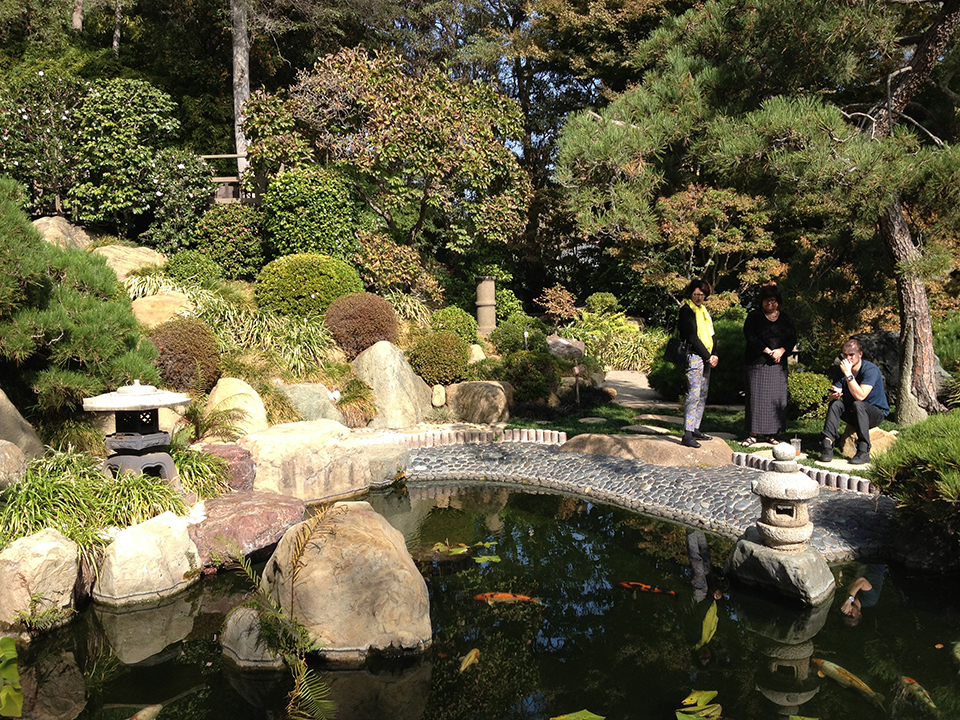 Hannah Carter Japanese Garden, Los Angeles, CA, 2013. Photo by Charles A. Birnbaum, courtesy The Cultural Landscape Foundation.
Hannah Carter Japanese Garden, Los Angeles, CA, 2013. Photo by Charles A. Birnbaum, courtesy The Cultural Landscape Foundation.
Dense plantings, many with Japanese origins, surround the pond, including pines, bamboo, magnolia, and camellia trees. At the garden’s highest point sits the hokura (family shrine), which contains a hand-carved gilt Buddha. On trips to Japan, the Guibersons personally selected the entry gate, hokura, and tea house that were imported for installation in the garden, along with stone lanterns, water basins, and carved and natural stones with symbolic significance that line the paths. The historic garden, completed in 1961, represents one of the preeminent examples of postwar, residential Japanese-style gardens.
The Hannah Carter Japanese Garden was also a “favorite place” of a young Pamela Burton, who in her Pioneers Oral History with TCLF recalled how she would climb over the fence to get in. On one occasion she snuck in a visitor who was in town for the weekend, the influential land artist Robert Smithson.
In 1964 the Chancellor of the University of California Los Angeles (UCLA), Dr. Franklin D. Murphy, expressed an interest in acquiring the garden for use by the university for several years, in order to “build some beauty and felicity” into the UCLA campus. “I was always bothered by the fact that Harvard and other universities had wonderful gardens,” Murphy said, “and UCLA had absolutely nothing.” That same year University of California Regent Edward W. Carter purchased the house and garden. He negotiated an agreement to subdivide the property and provided funds to UCLA to purchase the garden.
Extensive flooding in 1969 resulted in a mudslide which damaged the garden, during which time UCLA Campus Architect and Professor Koichi Kawana was engaged. Kawana maintained a long relationship with UCLA beginning in the 1950s as a student, continuing into the 1960s as a teaching fellow for the Art Department, and becoming a principal campus architect in 1963, a position he held until his retirement in 1989. While engaged with his UCLA duties, including the reconstruction of the Hannah Carter Japanese Garden, he was also an active private practitioner, founding Environmental Design Associates, a Los Angeles-based design firm in 1966.
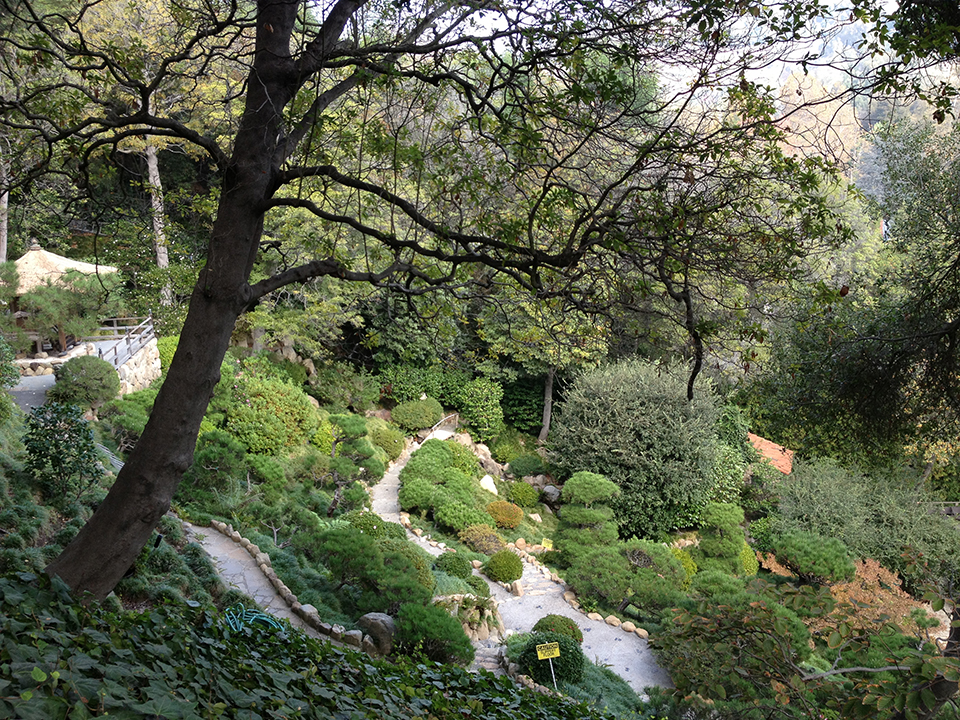 Hannah Carter Japanese Garden, Los Angeles, CA, 2013. Photo by Charles A. Birnbaum, courtesy The Cultural Landscape Foundation.
Hannah Carter Japanese Garden, Los Angeles, CA, 2013. Photo by Charles A. Birnbaum, courtesy The Cultural Landscape Foundation.
In 1982 Carter amended the terms of his donation to name the garden in honor of his wife, Hannah and, most significantly, to require the university to "retain the garden portion in perpetuity." Carter also said that the residence, part of the original 1964 bequest, could eventually be sold to provide an endowment to maintain the garden and provide funding for other purposes. In 1999 the university reaffirmed its commitment to the terms to “maintain the garden portion in perpetuity” along with the rest of the bequest.
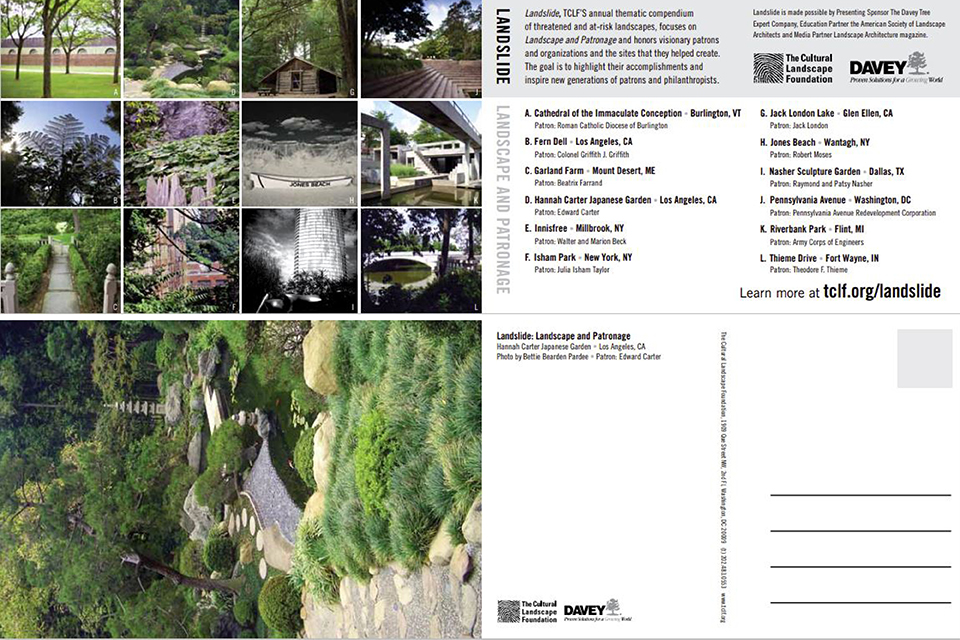
Landscape and Patronage Postcard Pack, 2012. Image courtesy The Cultural Landscape Foundation.
Advocacy and Engagement
In 2010, a year after her death, UCLA, without notifying Hannah Carter's children, persuaded a Superior Court judge to overturn the "in perpetuity" terms of the bequest, and in March 2012 listed both the house and garden for sale. A coalition that included TCLF, several Carter heirs, the Los Angeles Conservancy, and other groups strenuously advocated for the garden’s protection. In a statement to TCLF, Hannah Carter’s then 26-year-old grandson Alex Caldwell said: “I am working to help save the Hannah Carter Japanese Garden, and it is my first experience with landscape stewardship.” He later added, “UCLA would rather sell this whole plot to a developer for a paltry increase in their bank account than preserve it ... This, of course, is after promising the garden's donors that it would be kept open in perpetuity. The whole situation, to me, stands for everything that is wrong in the world, and I believe that what we are doing is not only saving a truly remarkable cultural landscape, but also standing up for what is right.”
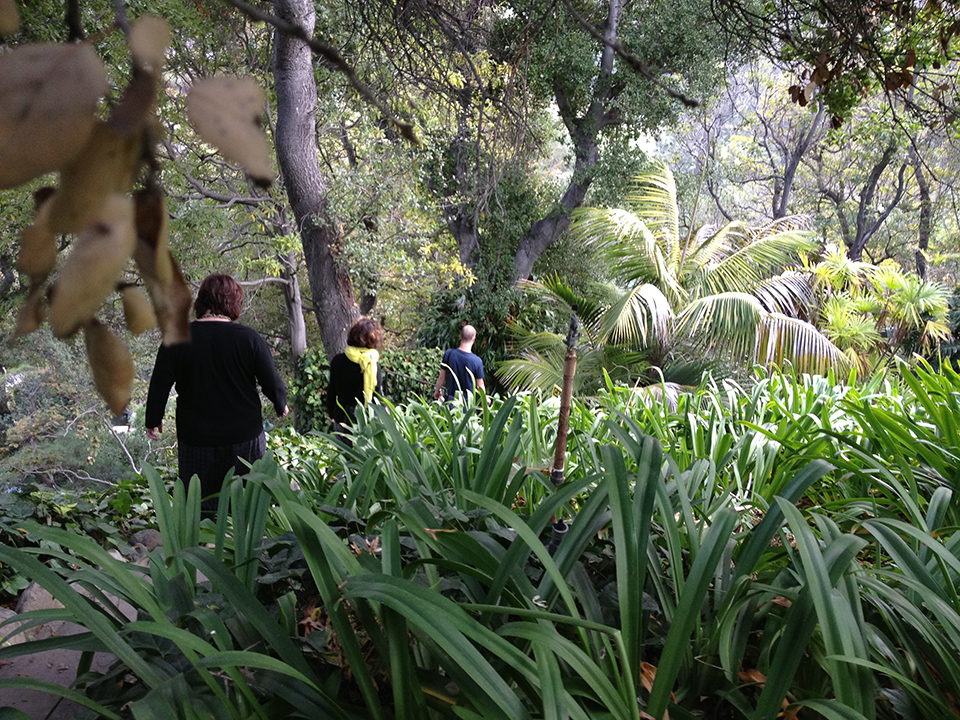 Alex Caldwell (right) descends a path in Hannah Carter Japanese Garden, Los Angeles, CA, 2013. Photo by Charles A. Birnbaum, courtesy The Cultural Landscape Foundation.
Alex Caldwell (right) descends a path in Hannah Carter Japanese Garden, Los Angeles, CA, 2013. Photo by Charles A. Birnbaum, courtesy The Cultural Landscape Foundation.
Concurrent with Caldwell’s statement, on January 23, 2012, the garden was enrolled in TCLF’s Landslide program of at-risk landscapes. TCLF urged the public to contact the UCLA Chancellor and University of California Regents to halt the sale and secure a public-private partnership that would maintain and operate the garden for future generations. TCLF also included the Hannah Carter Japanese Garden in the 2012 thematic Landslide report and digital exhibition, Landscape and Patronage (which included Innisfree, also in this year’s report).
After months of being ignored by UCLA, the Carter heirs filed a breach of contract suit and on July 27, 2012, a Los Angeles County Superior Court judge issued a temporary injunction delaying the sale of the garden and upholding UCLA’s legal obligation to maintain it. The university ultimately reached an agreement in October 2015 with the Carter heirs, which permitted the sale of the garden to developer Mark Gabay in June 2016 for $12.5 million on condition that the owner maintain and preserve it for 30 years.
In 2017, the residence and now-private garden were declared a Los Angeles Historic-Cultural Monument. The L.A. Department of Planning found that the garden was “an excellent and intact example of a Japanese-style residential garden.” Earlier this year, the estate was listed for sale – for $39 million. Fortunately, the garden’s Historic-Cultural Monument designation will help to protect this treasured cultural landscape for future generations.
Selected Resources
“Landslide Update: Hannah Carter Japanese Garden,” June 23, 2023
“Hannah Carter Japanese Garden Sold for $12.5M,” June 20, 2016
The Hannah Carter Japanese Garden Gets a 30-Year Reprieve,” October 2, 2015
“Judge Issues Preliminary Injunction Blocking Sale of Japanese Garden by UCLA,” August 9, 2012
"UCLA Violates Regent’s Bequest and Endangers Rare Private Japanese Garden,” May 2, 2012
“Collaboration Proposed Between Coalition and UCLA,” February 27, 2012
Selected Media Coverage
“Judge Blocks UCLA’s Proposed Sale of Japanese Garden in Bel-Air,” Martha Groves, The Los Angeles Times, July 28, 2012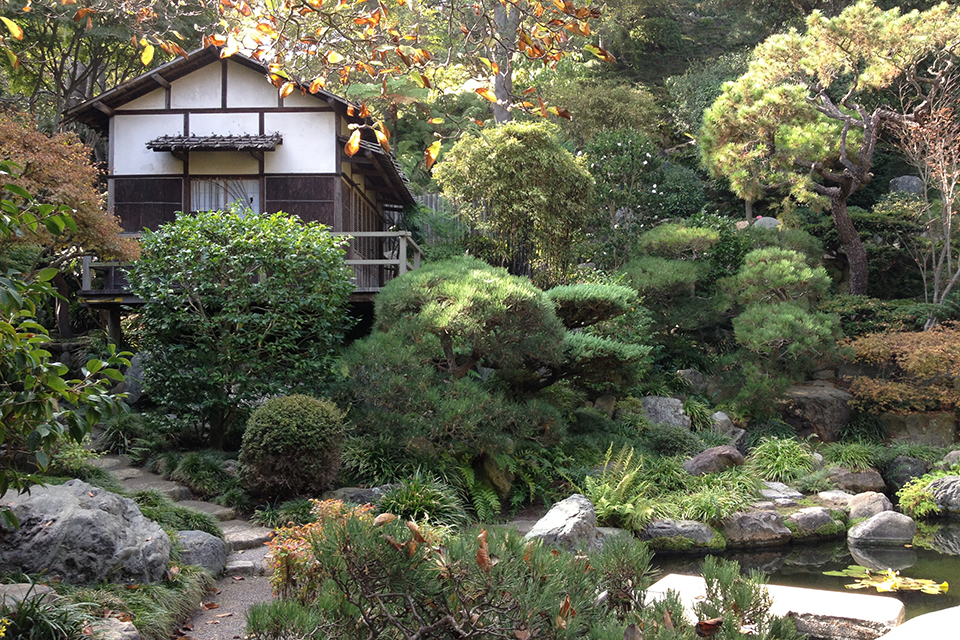
-
Hannah Carter Japanese Garden, Los Angeles, CA, 2013. Photo by Charles A. Birnbaum, courtesy The Cultural Landscape Foundation.
